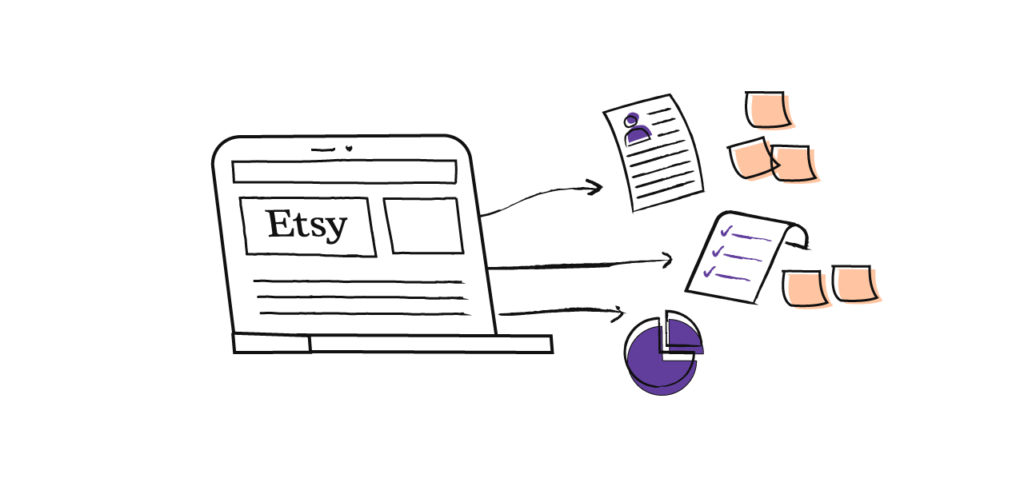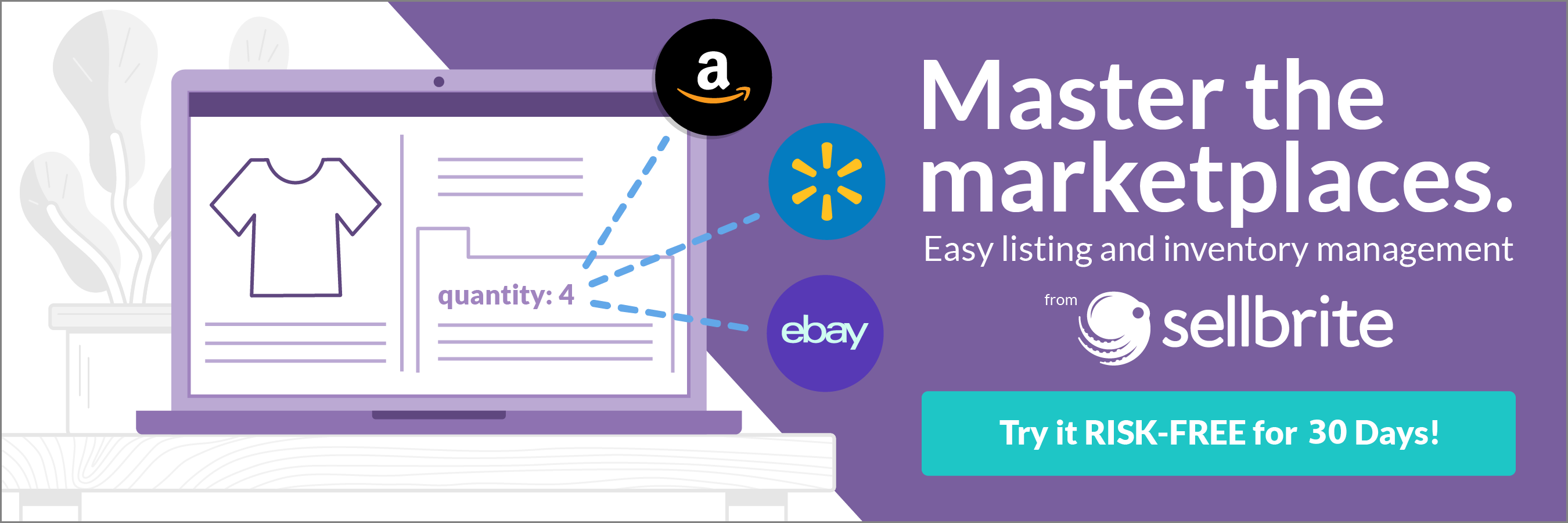You’ve built a product that makes you proud. You’ve set up your business and launched your Etsy store, and your garage is full of items waiting to be sold.
And then you realize you’re one of the 2.5+ million sellers on Etsy.
Buyers not only need a reason to buy from you; they also need a way to find you amid all the other sellers. If you want to grow your business, you’ll have to do more than rely on Etsy search results. You need a plan for reaching your target buyers with relevant, engaging content that leads them to purchase.
“The best Etsy sellers are particularly good at telling their story and good at making connections with people who buy their goods,” says Jennie Smith, Etsy’s former seller growth manager.
The good news is, you don’t need a big budget or a lot of experience to be successful with Etsy marketing. You just need to know your audience and have a plan for reaching them with relevant, engaging content.
Here’s what you need to know to start marketing on the four most important platforms for Etsy sellers: Etsy, Pinterest, Facebook, and Instagram.
Etsy Platform Marketing
Before you branch out to social media, it’s important that you make the most of the Etsy platform itself. Etsy gets hundreds of millions of visits monthly from shoppers who are looking for unique handmade products like yours. There are two ways to reach these shoppers: search engine optimization (SEO) and advertising.
Etsy SEO
Every other marketing strategy and tool mentioned in this article is optional. Etsy SEO is not.
In order to capture traffic from searches on Etsy, you need to make sure your product listings are discoverable. There are two steps to this.
First, you must optimize your listings for query matching,the part of the search process where Etsy matches a shopper’s search to relevant products. This means that your listing title and tags, categories, and product attributes are structured around keywords.
Learn more about this process in our dedicated guide to Etsy SEO.
You want to use a variety of keywords so Etsy can match your product to all relevant search terms. Shoppers who are looking for a gift for their cat-loving friend may have a very specific product in mind (such as a personalized mug), or they may be browsing for ideas. You want them to find your product in both searches.
For example, this personalized cat mug ranks on page one for “cat mug,” “cat lover gifts kitchen,” “personalized cat gift,” and more. It leverages a variety of keywords in its title and tags, so shoppers can find the listing no matter what variation of search terms they use.
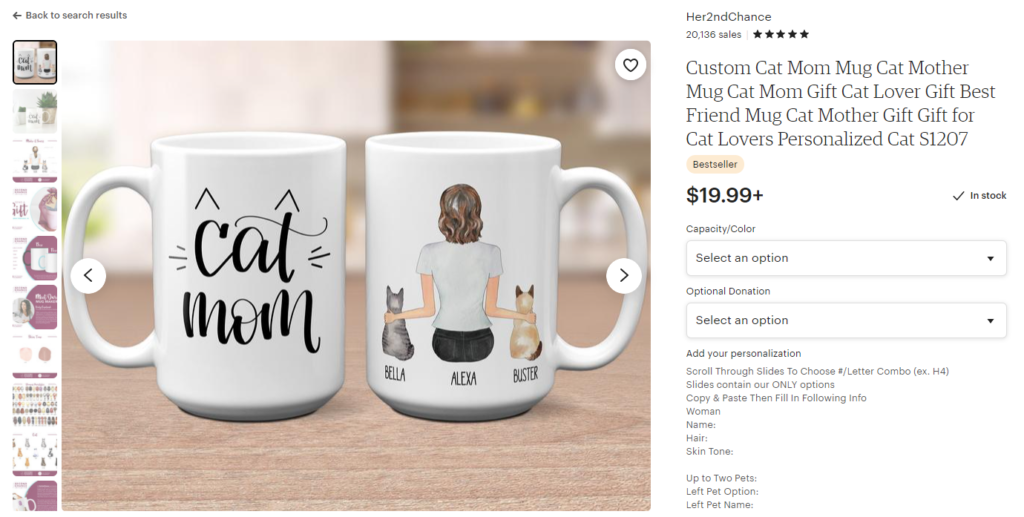
To choose the right keywords for your listings, you need to be both empathetic and analytical. Put yourself in your buyer’s shoes—what would drive them to your product? You also need to look at the data—what terms are people using to find products like yours?
Spyfu’s Ultimate Guide to Keyword Tools for Your Business includes a comprehensive list of Etsy keyword research tools, as well as general keyword research tools. Use these tools to gather ideas and cover all your keyword bases.
The second element of Etsy SEO is ranking.This is how Etsy determines whose products are shown first. Listings with keywords that exactly match the shopper’s search query are shown first because they’re considered more relevant. Etsy also gives each listing a quality score based on how often that product is purchased. Etsy’s goal is to ensure that the top-ranked listings give buyers what they want. A high rate of people leaving a listing without making a purchase indicates unmet expectations.
Besides keyword selection and conversion rates, there are a number of other things you can do to improve search ranking:
- Put effort into getting good reviews for your store. This shows Etsy that your product satisfies buyers.
- Be competitive with your shipping price. Not everyone can offer free shipping, but shipping price does impact your search ranking.
- Occasionally update and relist your products. Etsy gives a little extra weight to recent products. Since reviews are tied to your store, not individual listings, relisting your products may provide a temporary boost in search rankings.
This all takes time and effort, which pays off in the long run but might not drive the sales you’re hoping to see today. Your other option for marketing on Etsy is advertising.
Etsy advertising
Etsy offers two advertising programs to help you reach buyers. The first and most effective is Etsy Ads.
Etsy Ads make your products more visible by featuring them in search results, on category pages, and at the bottom of other product pages. Even if your products don’t naturally rank high in search, you can jump to the front of the line and show your products first by using these ads.
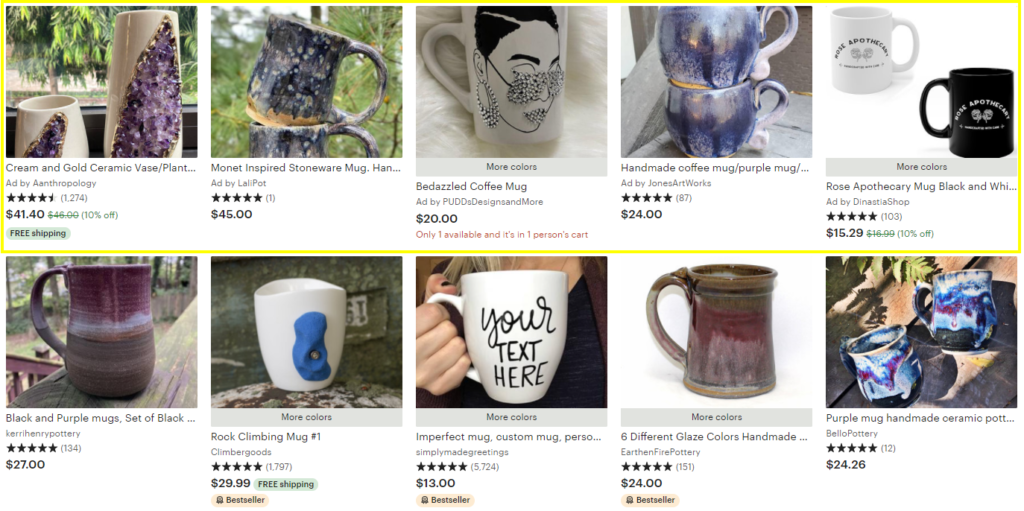
Where your products are displayed depends on how much you pay. Etsy Ads works on a cost-per-click basis, which means that you pay whenever someone clicks on your ad. However, unlike other advertising platforms, you’re not directly in control of how much you pay per click.
Instead, you’ll set a daily budget. This determines how much you’re willing to spend on ads on a given day. Etsy’s algorithm takes this budget into account when deciding where to show your ads.
Every time a search is made that fits your product listing, Etsy runs an auction for all relevant advertisers. Your automated bid will be as competitive as possible while also staying within the bounds of your budget. For example, Etsy won’t let you spend $1 on a single click if your daily budget is only $3. The highest bids win the best positions, so those with bigger daily budgets will tend to win top slots more often.
However, Etsy also takes listing quality into account. If you have a high-quality listing, with optimized data and a history of positive reviews, you may not have to spend as much as sellers with lower-quality listings to be competitive in the advertising auction.
Setting up your Etsy ad campaign is easy. You need to set only two factors:
- Daily budget: The maximum you’re willing to pay for ads. Etsy’s algorithm won’t exceed this budget and will turn off advertising once the cap is hit.
- Targeted listings: The product or products you want to advertise. You can choose as many or as few as you want.
When you’re just getting started, Etsy recommends that you run a campaign that targets all your products and has a daily budget of $3 to $5. Running this campaign for 30 days gives Etsy’s algorithm the time it needs to process your data, run experiments, and optimize your advertising.
Once this initial period is over, try experimenting with your budget and product targets. Review your ad performance frequently to see what’s working for you. While Etsy doesn’t offer much control over advertising, you can still use metrics, such as orders from ads, to determine which products are worth advertising.
Etsy also recently started offering their Offsite Ads program, which is essentially an ad-listing service. Through Offsite Ads, Etsy advertises your products on Google, Facebook, Instagram, Pinterest, and Bing. Etsy handles all the details and costs of listing and advertising your ads. You pay only when someone makes a purchase.
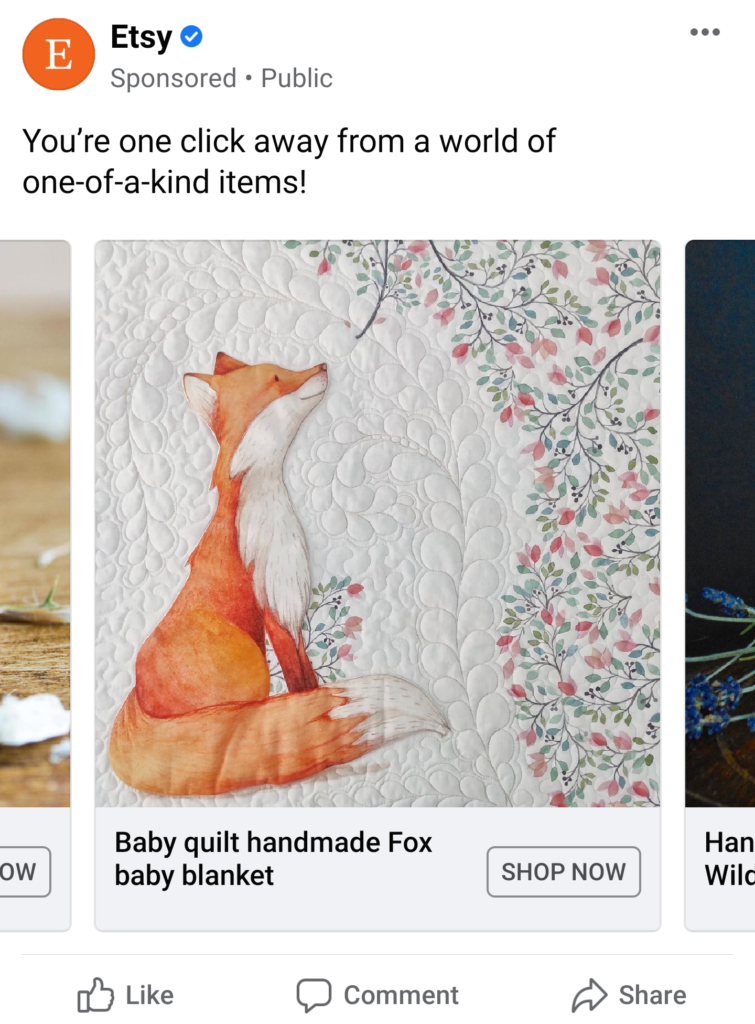
This means you benefit from the exposure of advertising without the risk of pay-per-click ads on these platforms. Just be prepared to pay Etsy 15% of the sale as a finder’s fee if your store makes under $10,000 annually (12% if you make more than that).
You don’t need to do anything to be enrolled in this program—Etsy automatically includes all sellers in their Offsite Ads programs. If you’re not interested in having Etsy advertise for you, you’ll need to opt out in your store settings. (Note that sellers making more than $10,000 a year are not currently able to opt out of the program.)
Before you start advertising, make sure your listings are optimized for conversions. You want to get the maximum mileage out of your ads, and a high-quality listing will help make that possible.
Pinterest Marketing
Pinterest is often lumped together with social media platforms, but, in reality, it’s a visual search engine. It’s also a highly engaging shopping platform, where 89% of users look for purchase inspiration and another 47% of users go specifically to shop. Pinterest also sees a higher average order value than all other social networks.
Pinterest’s visual nature makes it ideal for Etsy sellers. Pinterest users want to find something unique, something that fits their aesthetic and personality. Your job as an Etsy marketer is to give them just that.
Learn more about using Pinterest to grow your ecommerce business.
Create Pinterest Pins
The first step to marketing on Pinterest is to build your Pins. There are two ways to do this with Etsy products.
The best (and easiest) option is to create a product-rich Pin. A product-rich Pin includes your listing’s picture, pricing information, title tags, ratings, shipping information, and description, as well as a callout button directing shoppers to your store.
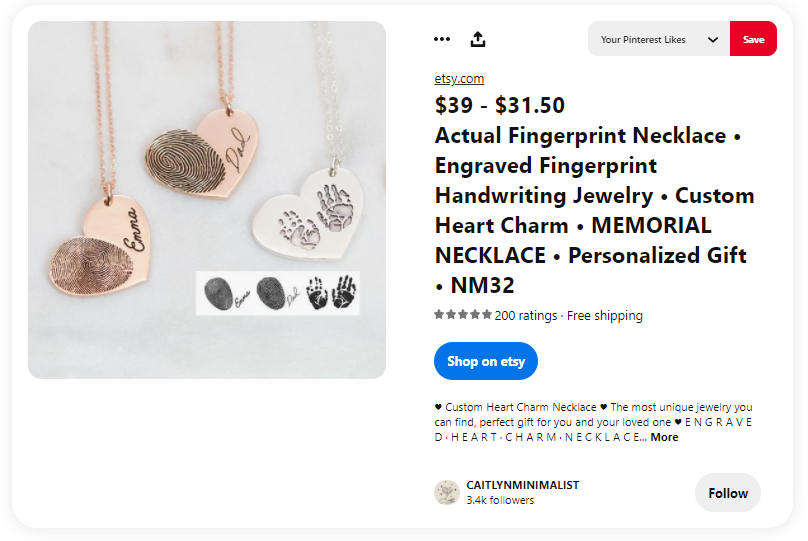
To create this Pin, go to your product listing page. At the top, under Listing Tools, you’ll see the option to save your listing to Pinterest. Once you do this, your Pin will be saved to your board and available to anyone on Pinterest.
Product-rich Pins are a must for Etsy marketing, especially since only product Pins can appear under Pinterest’s “Shop” tab.

However, as you build out your brand, you may also decide to create Pins with your own designs. This approach allows you to call out product collections and advantages of your brand (such as eco-friendliness) or include images that are more visually interesting than a product Pin.
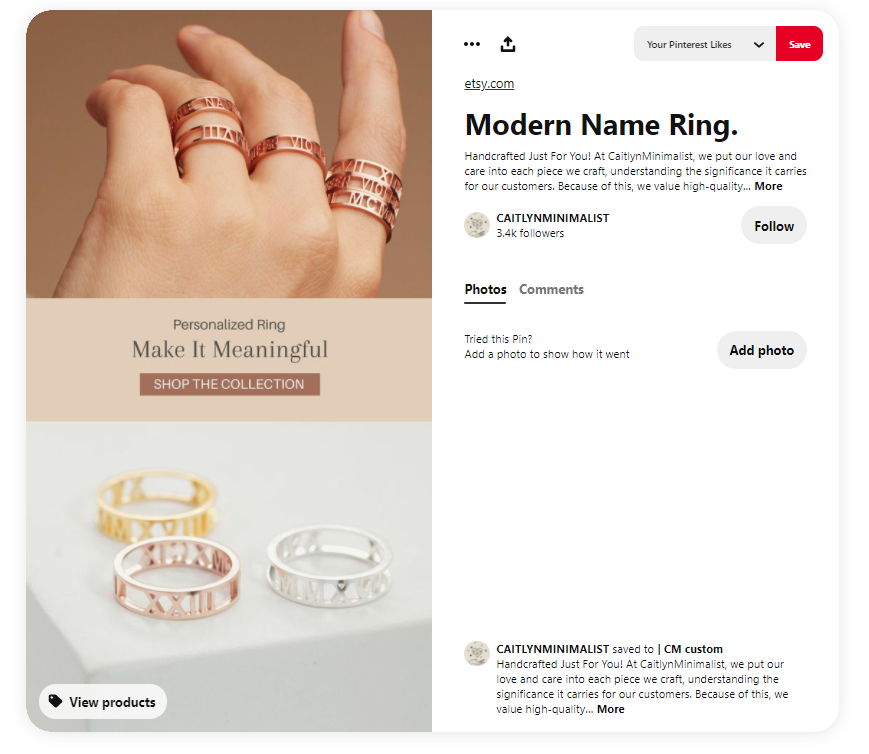
Create Pinterest Boards
Brand-to-user engagement is different on Pinterest than on Instagram or Facebook. You’re not trying to have a conversation with shoppers; you’re trying to inspire them. People go to Pinterest to gather ideas for their home, for projects, for their wardrobe—you name it!
The pins on Pinterest are organized and saved on boards, creating collections of ideas and inspiration. For example, a user could create a Pinterest board titled “backyard wedding” that features flower arrangements, decor ideas, and more. Or they might make one for “Thanksgiving recipes” and pin recipes from around the internet that they want to whip up for a holiday dinner.
The typical shopping process for Pinterest looks something like this:
- Shopper has a want or an idea. For example, Kelsey is moving to a new house in a few weeks and wants to decorate in a farmhouse-chic style.
- Shopper searches Pinterest. Kelsey searches “farmhouse decor” on Pinterest and starts browsing various boards, perhaps narrowing her search as she goes.
- Shopper starts pinning ideas to their own board. As Kelsey sees search results she likes (and browses the Suggested Pins under those results), she begins to create her own board, where she curates items she likes.
- Shopper starts buying items from Pinterest links. When Kelsey moves into her new place, she goes to her Pinterest board, where she’s saved everything she wants to buy, and finally makes her purchases.
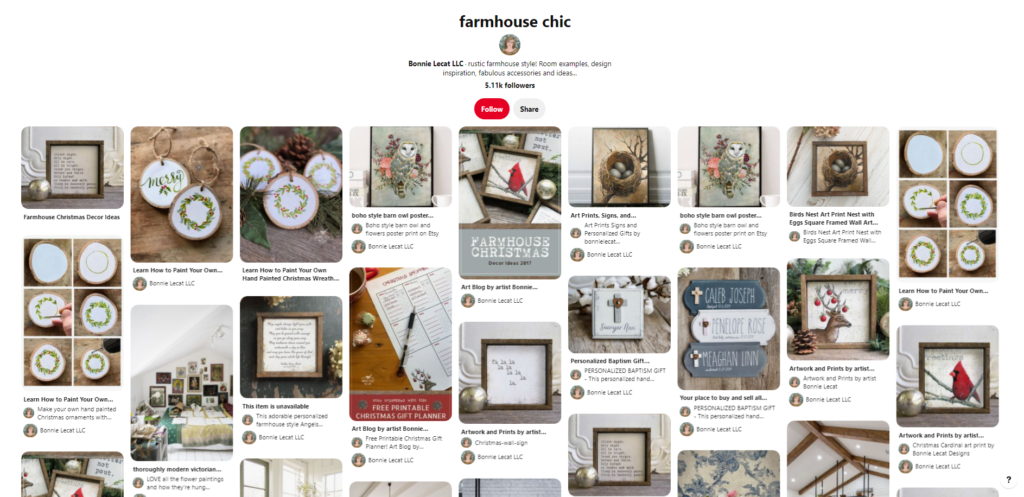
The exact route looks a little different for everyone. Some shoppers may find exactly what they’re looking for and make a purchase from search, especially if they’re looking for something like a gift instead of planning their home decor. But the path is the same: idea leads to inspiration leads to purchase. The goal of your Etsy marketing is to meet shoppers at the inspiration stage and lead them to make a purchase with you.
Pinterest boards are a great way to do this. By creating themed boards around your products, you can capitalize on shoppers’ ideas and help them imagine your product as part of their home, wardrobe, event—you name it!
Your Pinterest boards should be a brand showcase, not a product catalog. Take this example of CAITLYNMINIMALIST, one of the top sellers on Etsy. Only two of her boards (CM Custom and CM Timeless) explicitly feature her products, and one of her boards frames her products as Mother’s Day gifts. Her other boards build out her brand aesthetic.
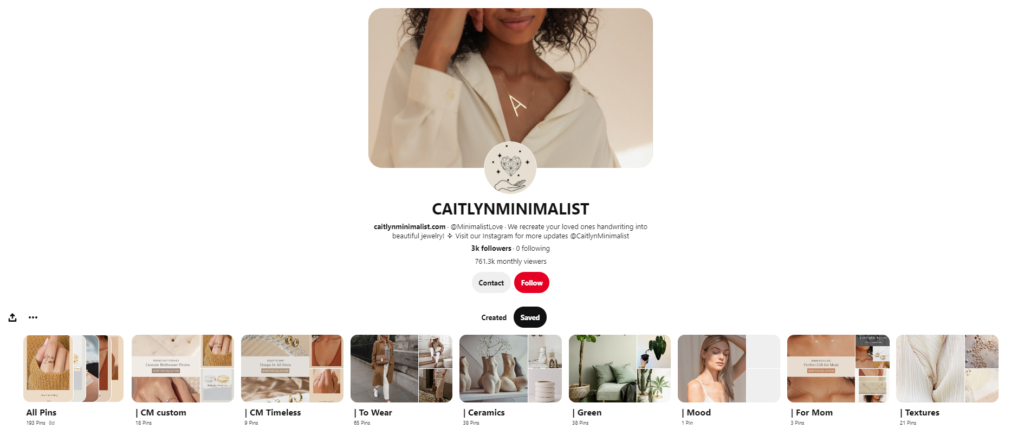
This is a smart move because pinners who share aesthetics or interests with a board will often follow the board and will sometimes follow the person who made the board. When your board gets followers, any additions you make to that board will show up in those users’ feeds. In other words, if you curate a minimalist aesthetic board, you can use it to attract followers who share your sense of style—and then gently promote your product via that board.
Want to learn more about leveraging your Pins and boards to drive sales? Check out Buffer’s in-depth guide to Pinterest marketing.
Pinterest Paid Advertising
We’ve already established that Pinterest is a must-have platform for Etsy marketing, but it can also be a little hit-or-miss when it comes to driving organic traffic. To ensure that you’re getting the most out of the platform, consider running advertising campaigns on Pinterest.
Advertising on Pinterest allows you to target user interests and search keywords, and you pay for campaigns only when a user takes an action that’s meaningful to you.
Your campaign objective tells Pinterest what those meaningful actions are. Here are the three objectives that are most relevant to Etsy sellers:
- Brand awareness,whichmeans your primary goal is exposure for your brand. You’ll pay a certain price (determined by you) for every 1,000 impressions your ad gets. This is also called cost per mille, or CPM.
- Traffic, which means you’re optimizing your ads for visits to your Etsy listing. You’ll set a cost-per-click (CPC) bid to determine how much you pay every time someone clicks through to your website from an ad.
- Conversions, which means you want Pinterest to optimize your campaigns to drive sales, specifically. This campaign objective is a little more involved because you’ll need to ensure that Pinterest can track conversion actions. With this objective, you pay a cost per action (CPA)—in other words, you pay when a conversion takes place.
Once you’ve set your campaign objective, you’ll create an ad group that defines your target audience, bids, and budgets.
- Target audience is the group of users you want to show ads to. Pinterest has seven different targeting options, so you can build a custom audience based on demographics, interests, keywords, and more.
- Maximum bid is the field where you’ll set your bids. This determines how much you’re willing to pay for a given action. The bid is based on the campaign objective you set. For example, if you chose a traffic objective, this maximum bid will tell Pinterest how much they can spend to earn you a single click. (Note that this isn’t the bid they will use every time; you’ll pay only what is needed to win the ad auction, up to that maximum amount.)
- Daily budget caps your advertising spending so you only ever pay a set amount on your advertising per day. This is an important way to keep your advertising profitable. To figure out your ideal daily budget, you’ll need some trial and error. See how well your ads perform and how often your daily budget ends your high-performing ads. This will let you know if your budget is set too low.
Last but not least, you’ll create your promoted Pins. These are the ads that will be shown to the audience you’ve defined.
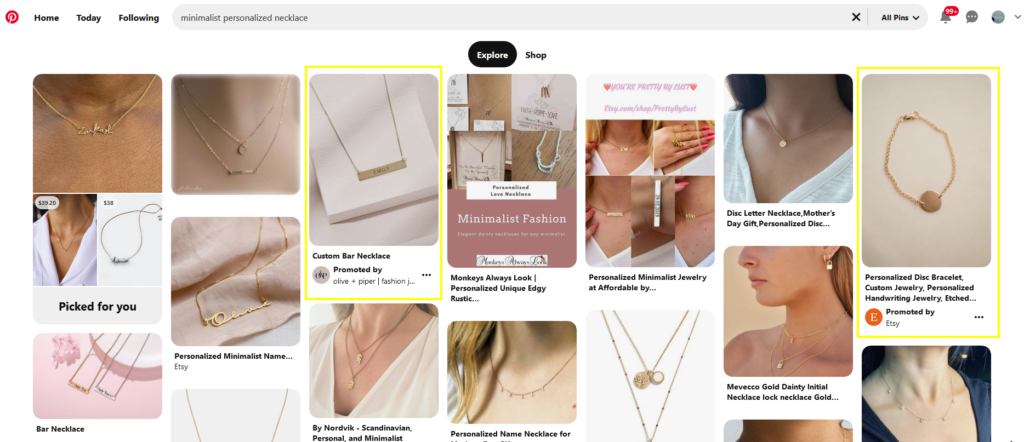
Promoted Pins are pulled from Pins you’ve already created, so make sure you have eye-catching ad creative ready to go. Simply select Pins to promote, add them to your ad group, and you’re good to go. While there are some advanced ad formats (such as video ads and carousel ads), the default Promoted Pin format is ideal for most Etsy sellers.
While advertising may feel like a totally different beast on Pinterest, just remember: the same rules apply to promoted Pins as to organic Pins. Use your ad-targeting options and creative abilities to create something that inspires shoppers, hits the right aesthetic, and meets shoppers with something they can love.
To learn more about Pinterest advertising and set up your own campaign, read this guide to getting started.
Etsy Marketing on Facebook
Instagram is ideal for Etsy marketing because it’s friendly towards niche communities and creative aesthetics. Facebook, its parent company, makes marketing your Etsy store far more challenging.
Organic reach for business on Facebook has been declining for a number of years now, as Facebook doubles down on its advertising. So while it’s important to have a business account with Facebook, most of its value for Etsy sellers is in its paid advertising options.
Facebook paid advertising
Facebook Advertising offers sellers a massive audience and detailed targeting options while still remaining fairly beginner-friendly. You can run ads laser-targeted to your ideal buyer, all while working within the constraints of your budget.
When launching an ad campaign, start by setting an objective. This tells Facebook what you hope to get out of your ad campaign and helps its algorithm optimize your ad budget. There are three categories of objectives available:
- Awareness campaigns promote visibility and exposure for your brand without necessarily driving direct traffic.
- Consideration campaigns encourage people to engage with your brand through actions like interacting with your Facebook posts, reaching out on Facebook Messenger, or visiting your website.
- Conversion campaigns feature products and specific calls-to-action (such as “buy now” or “add to cart”), with the goal of driving sales directly from your ad.
Conversion campaigns are the best option for Etsy sellers, especially those just getting started with advertising. This is where you’ll see the most direct ROI.
Once you’ve chosen your objective, you’ll start building ad sets. This is where you’ll define your audience, choose your ad placements, and add your budget. Facebook is good at walking you through this process.
Keep in mind, defining your audience is the key to a profitable ad campaign. Facebook’s targeting options are rich, and you should make the most of them. Don’t skimp on this step—add as much detail as you can.
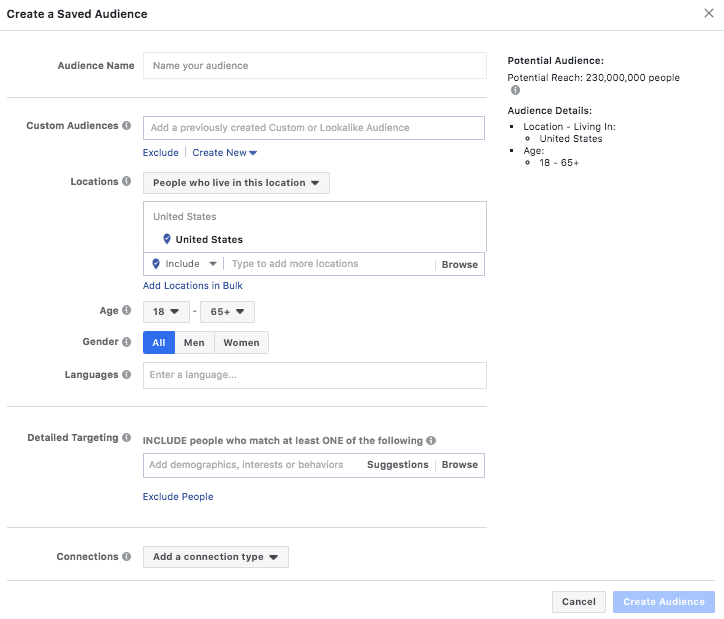
You’ll need to fill in some basic info for your audience—location, age, gender, and language. However, the real power of audiences lies in detailed targeting. These targeting options are split into three categories:
- Demographics cover everything, from relationship status and income to political affiliation and education level.
- Interests draw data from liked pages and online interactions to identify a user’s hobbies, activities, and tastes.
- Behaviors look specifically at purchase patterns and intent to help you target people who are more likely to make a purchase.
You can include as many or as few of these detailed targets as you want. The more targeting options you add, the narrower your ad exposure. But on the flip side, a highly qualified audience is more likely to make a purchase.
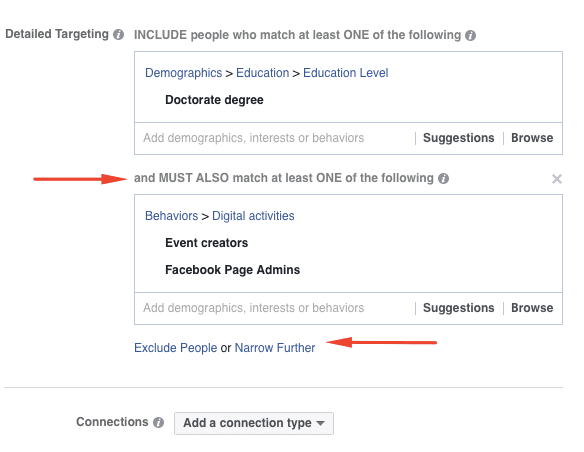
To put this in more concrete terms, let’s say you sell personalized gifts for outdoorsy couples. You could create an ad campaign that promotes your product as the ideal anniversary gift. For this kind of campaign, you’d want to choose the following targeting options:
- Demographics > Relationship > Married
- Demographics > Life Events > Anniversary within 30 Days
- Interests > Sports & Outdoors > Outdoor Recreation
- Behavior > Anniversary within 61-90 Days
This allows you to fine-tune your ad creative, knowing you’ll only be showing your ads to people with an interest in outdoor activities who have a wedding anniversary coming up.
Once you have your audience set up, you need to choose your ad placements. This is where you can tell Facebook to show your ads on Facebook, as well as on Instagram. Bear in mind that a campaign can have multiple ad sets. We recommend creating a separate ad set for Instagram ads, as this will help you monitor and fine-tune performance.
Next, tell Facebook how to optimize ad delivery. This goal is different from your campaign objective. Essentially, you’re telling Facebook’s algorithm exactly what you want from this campaign (conversions, impressions, clicks, etc.). Facebook’s algorithm will then optimize your ad set for this metric based on the data it gathers.
Last but not least, you need to set your daily budget. This tells Facebook how much money it can spend on your ads every day on average. Note that Facebook may spend up to 25% more than your daily budget on a given day (unless you put cost controls in place). Since Facebook doesn’t allow you to set exact bids for targets, your daily budget is the only way to increase the amount of traction you get from your ad campaigns.
Once you’ve created your ad set, you’re good to create your Facebook ads. Facebook offers many of the same ad formats as Instagram, designed to look native in Facebook’s interface. Again, experimentation and creativity are key to finding the ad types that work best for your business. (Here are some ad ideas to help you get inspired.)
Facebook Advertising is fairly simple to get started with, and there’s a wealth of ways to fine-tune your advertising and maximize profits. We recommend reading The Beginner’s Guide to Facebook Advertising for an in-depth walkthrough on creating your own Facebook campaigns.
facebook groups
As we mentioned earlier, by placing more emphasis on engagement (and advertising), Facebook has made organic reach difficult for business pages.
However, Facebook groups have been gaining traction as an organic marketing strategy for small businesses. Groups are built around common interests or communities and create a place for people to engage with each other—or with their favorite brands.
A Facebook group isn’t likely to drive new customers, but it’s a great way to build relationships with people who have purchased from you or who are familiar with your brand. Many small businesses offer their Facebook group as an exclusive community for customers, where they can connect with likeminded people and access special content and promotions.
Think of this as ongoing marketing for your Etsy store. By engaging your customers even after they purchase, you make them more loyal to your brand and more likely to promote your brand to friends.
When planning a Facebook group, consider your customers’ interests and how they align with your product. For example, if you sell knitting patterns on Etsy, you could create a group for knitting enthusiasts to share projects and techniques. Weekly posts could promote a “project of the week,” and you could leverage Facebook Live events to teach knitting skills.
There’s no one right way to run a Facebook group, so get creative! The goal is to build something uniquely you, to generate a sense of connection with your brand.
Read this guide to learn how to use Facebook groups to grow your business and engage customers.
Etsy Marketing on Instagram
The visual and interactive nature of Instagram makes it an ideal social media platform for marketing Etsy products. More than that, it has an active community of shoppers. In fact, 60% of people discover new products on Instagram.
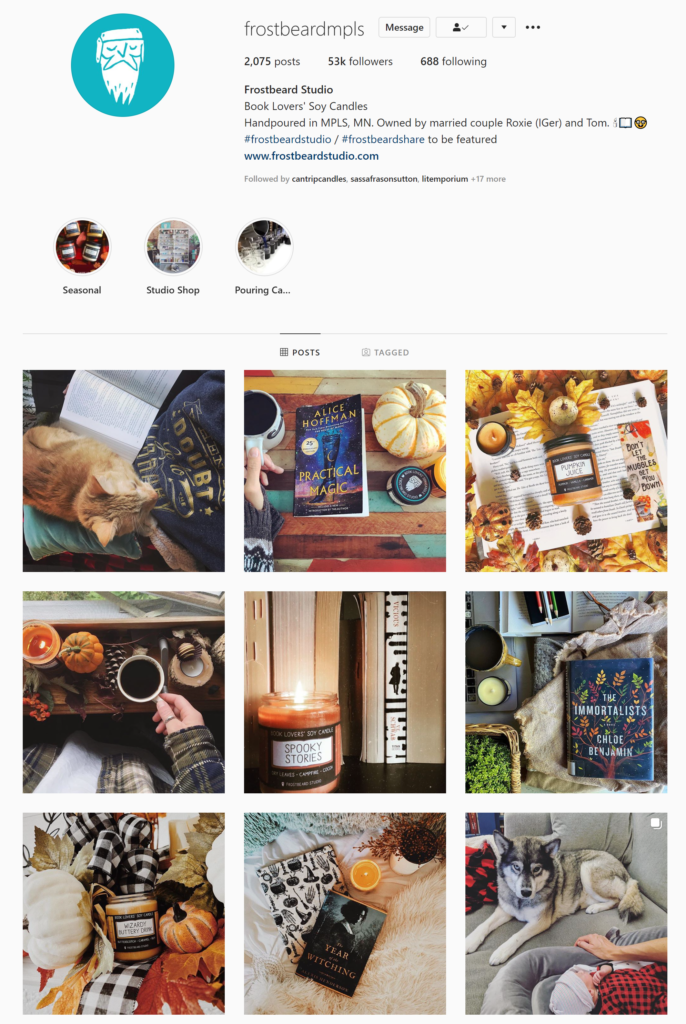
Getting started with Instagram marketing is easy. First, set up an Instagram business account. While you can use a personal account to market your Etsy store, a business account gives you access to analytics and features that you wouldn’t have with a personal account.
When creating your profile, you want to look as professional as possible. Use your store logo instead of a personal picture, and make sure your account description makes it clear what you sell. A verified badge is not necessary but can be a good trust signal.
Last but not least, you’ll need to link to your Etsy store in your bio. If you have a blog or independent ecommerce store or just want to highlight certain products, look into a “link in bio” tool. These tools essentially turn your Instagram bio link into a directory of all your important content.
Once you’re setup, it’s time to start creating content.
Create engaging organic content
When you post on Instagram, the goal is to engage your ideal buyers with eye-catching visuals, an authentic brand, and captions that promote interaction. Your images can get as creative or be as minimal as you want, so long as your content contributes towards a consistent brand aesthetic. This will help you establish your store in the minds of your followers and differentiate you from other content on the platform.
But great content alone won’t get you followers. To make sure your Instagram content reaches the right eyes, you need to craft a hashtag strategy that helps you reach people who will be interested in your products.
Instagram users often follow hashtags that are relevant to their interests. If they follow a hashtag you use in a post, it can appear in their personal feed, even if the user doesn’t follow you. This makes hashtags essential to account discovery.
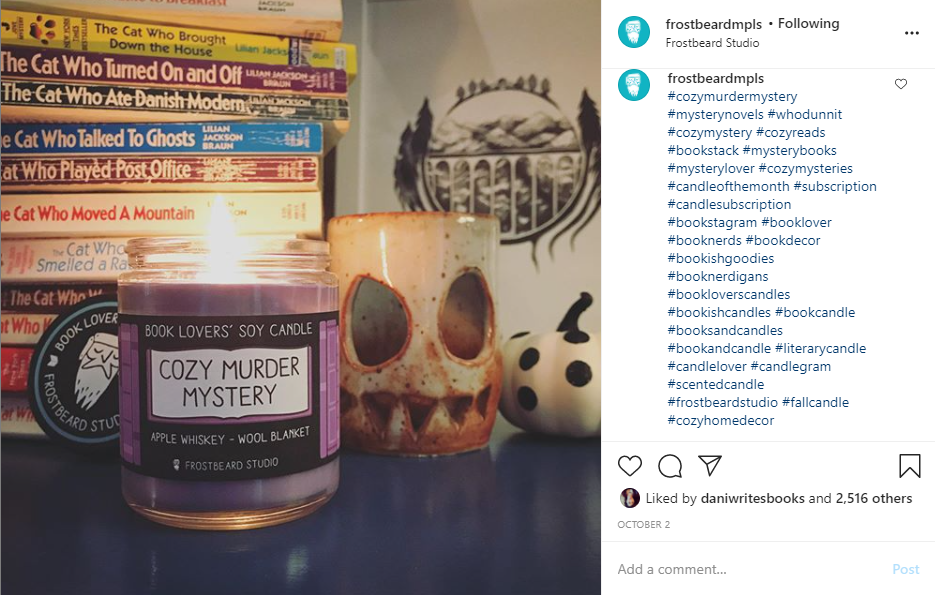
It’s well worth the time to dig into the science and strategy of hashtags on Instagram. We recommend reading The Ultimate Guide to Instagram Hashtags in 2020to get started.
Once you’ve attracted followers, you need to keep them engaged. Beautiful, eye-catching photos are a great start, but passive followers rarely become buyers—you want people to interact with your posts, not just admire them. There are a few key ways to do this.
- Write engaging captions. The goal here is to generate comments, discussion, and a sense of community around your brand. Ask for opinions on new projects or products. People always love to give their opinions on social media, and soliciting this feedback makes them feel like a small part of your process.
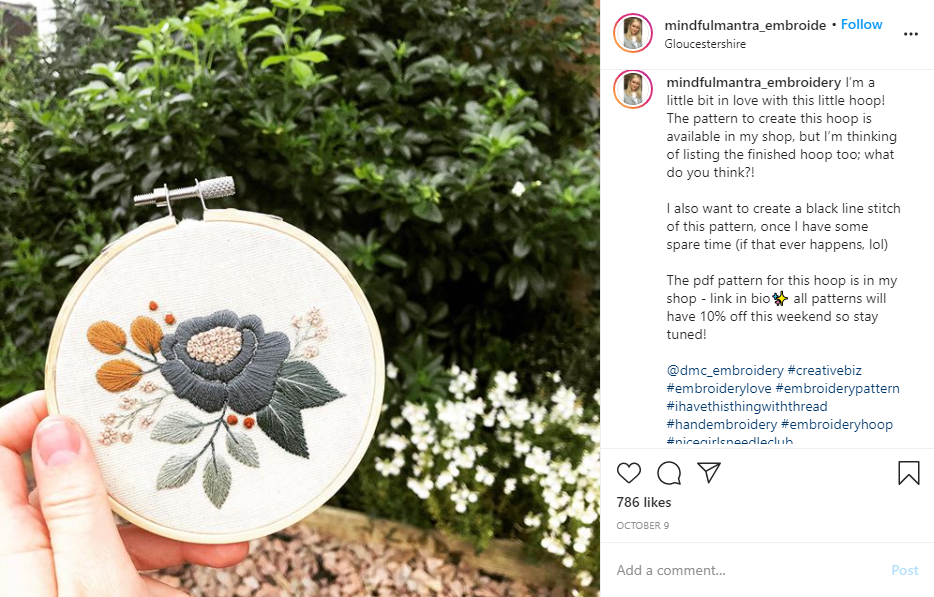
Post behind-the-scenes content, especially videos. It’s always fun to get a peek behind the curtain, and this will help people feel more connected to you and your store. This ability to connect is one of the perks of being a small, creative business—make the most of it!
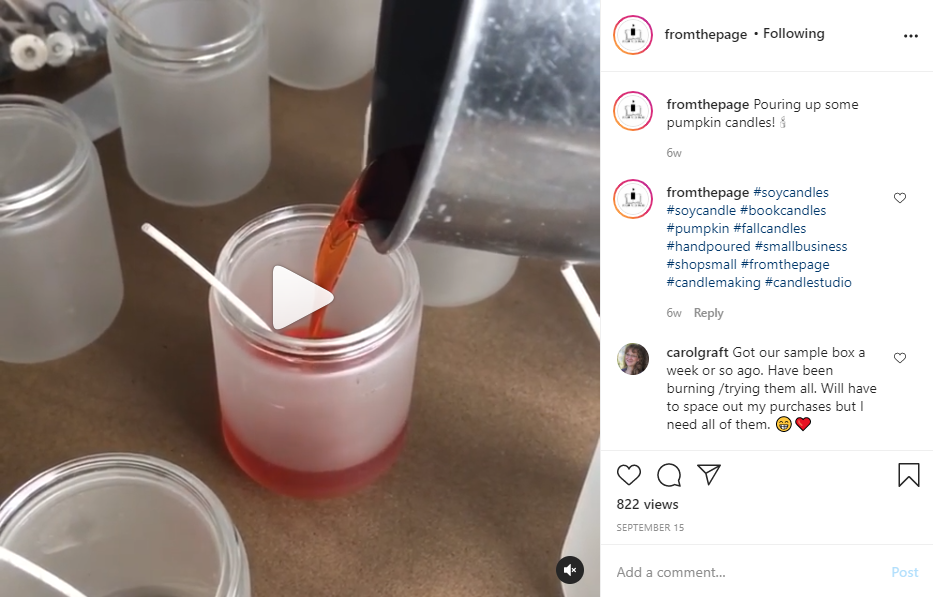
Post your thoughts on topics related to your shoppers’ interests (bonus points if you include discussion questions). For example, if you sell products geared toward book lovers, post content about your favorite books. You’ll see more engagement if your posts aren’t always about your products.
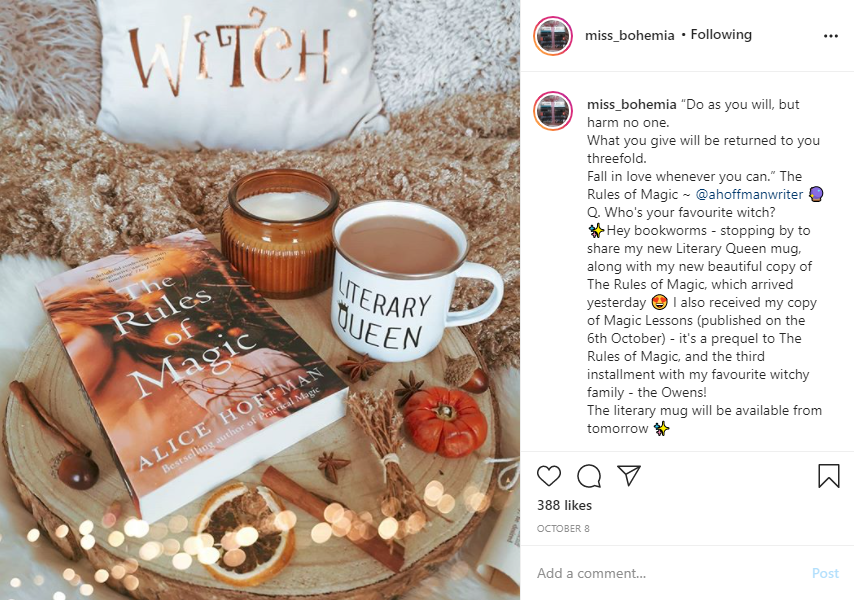
The key here is to vary your content—you want a good mix of product-showcase posts and community-building posts. As you see what resonates most with your audience, adjust your mix to focus on that.
Set up shoppable posts
Your next step is to make your Instagram posts shoppable. This post format lets you call out the products in your regular posts, include pricing details, and link directly to your product page. All shoppable posts are highlighted on your profile page with a shopping bag icon, and followers can even navigate directly to a shopping tab to view your products directly.

When followers see a post in their feed, they’ll have the option to view the product. The price is available directly in their feed. If they click on the “view products” button, it will take them to a shopping page on Instagram where they can continue their purchase journey and see your other products.
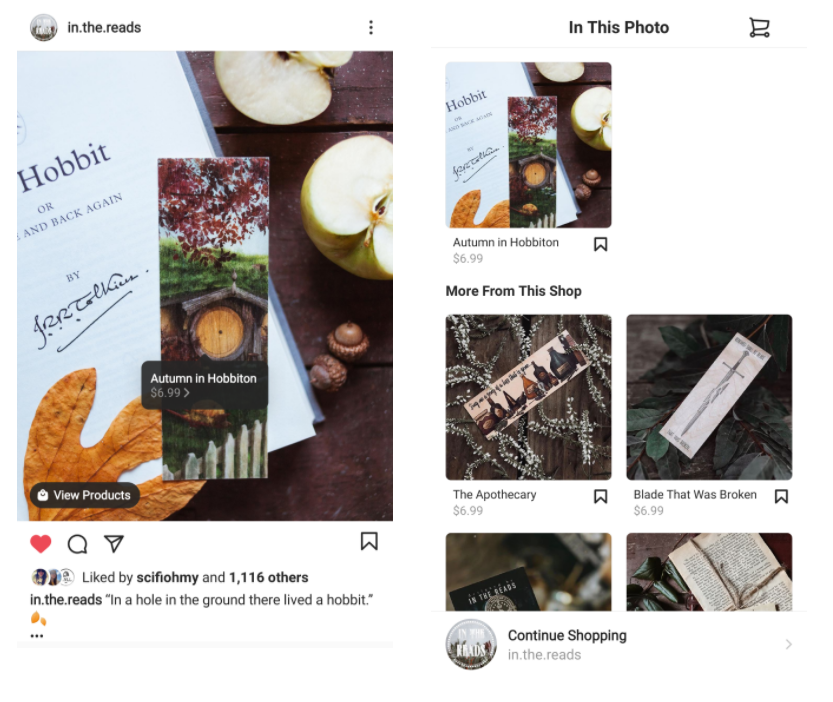
One more click on your product will lead your follower to a mini product-page with a link to your store.
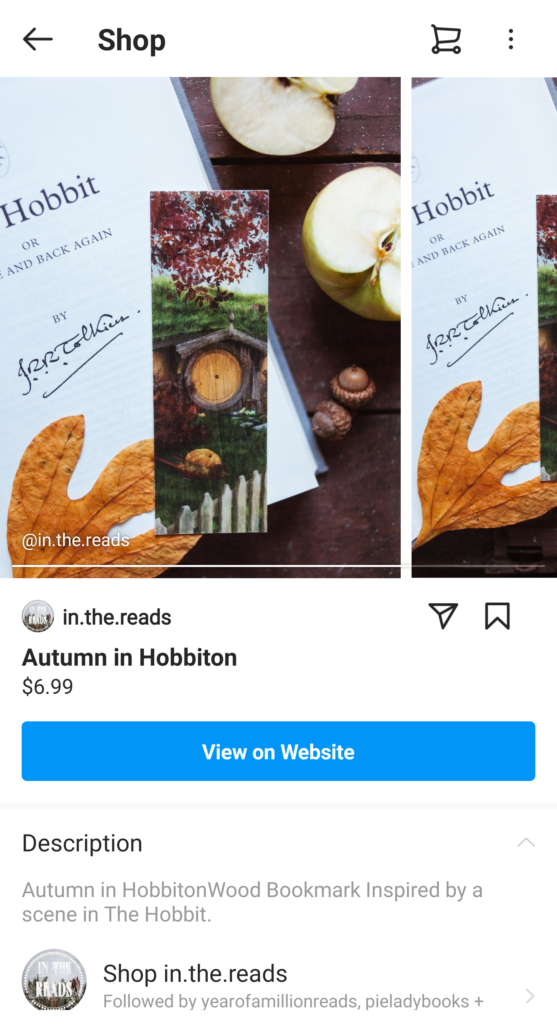
To set up shoppable posts, you’ll need to set up a product catalog via Facebook Business Manager and link this to your Instagram account. It does take a little legwork upfront, but it’s worth the effort to ease the customer journey between Instagram and Etsy.
Etsy seller Tyler Wentworth of Wentworth Vintage gives an excellent step-by-step walkthrough video to help you get these shoppable posts set up.
Shoppable posts and engaging content are the two biggest ways to do Etsy marketing on Instagram, but Stories, Instagram Live, and influencer partnerships are also great ways to reach your audience. Here are some resources to get you started:
- How to Use Instagram Stories Ads to Attract New Customers
- Instagram Live Video Examples That You can Use to Attract New Users
- Influencer Marketing in 2020: 5 Guidelines for Maximizing the Results of Working With Influencers
Lastly, check out our article on driving traffic to your Etsy store from Instagram for a more in-depth guide to Instagram marketing.
Instagram paid Advertising
But Instagram’s marketing potential isn’t limited to organic reach. Paid advertising on Instagram provides fast access to Instagram’s users to help you drive sales and build brand recognition.
Instagram advertising is very simple for beginners while also offering layers of control and complexity that can be useful as you grow your business.
Instagram ads are run through the Facebook Advertising platform, so you’ll create campaigns for Instagram the same way you create Facebook campaigns. Since Instagram is a more visually driven platform than Facebook, you’ll want to pay extra attention to the design of your ads and use available ad formats strategically. You have four different ad types you can use on Instagram:
- Photo ads are the easiest ad to start with. You can promote an existing Instagram post instead of creating a brand new ad creative. But unlike your organic content, you have the advantage of targeting the ad toward audiences. Use photo ads to promote attention-grabbing photos of your product and direct users to your site with a CTA button.
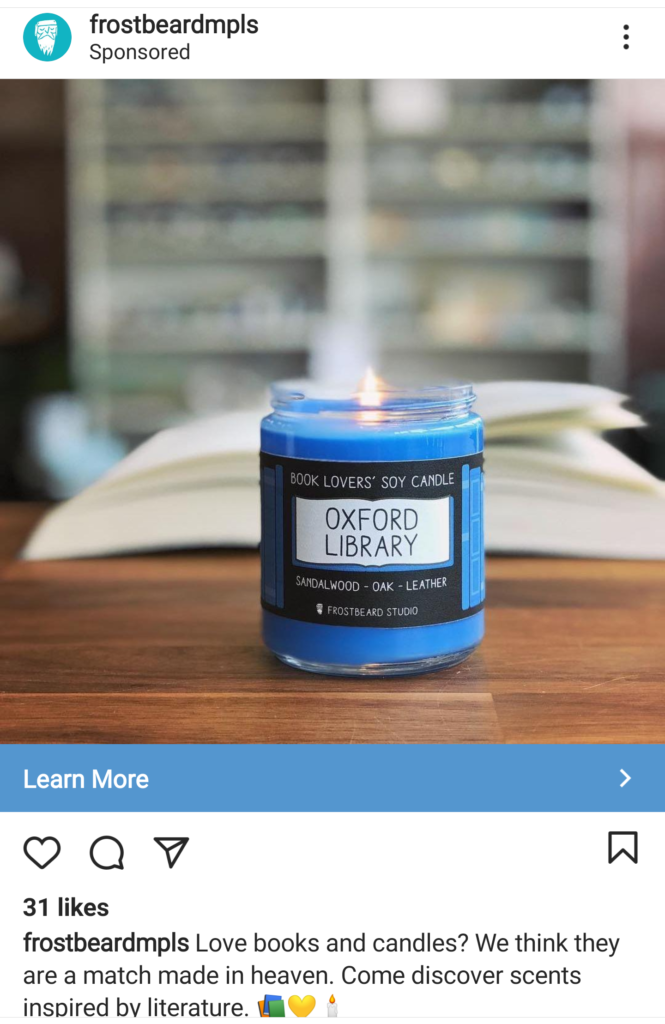
Carousel ads are a variation of photo ads—instead of one photo, you can display several. This ad type is ideal for showing off a collection of items or for combining product images and text slides to call out the features and benefits of your product.
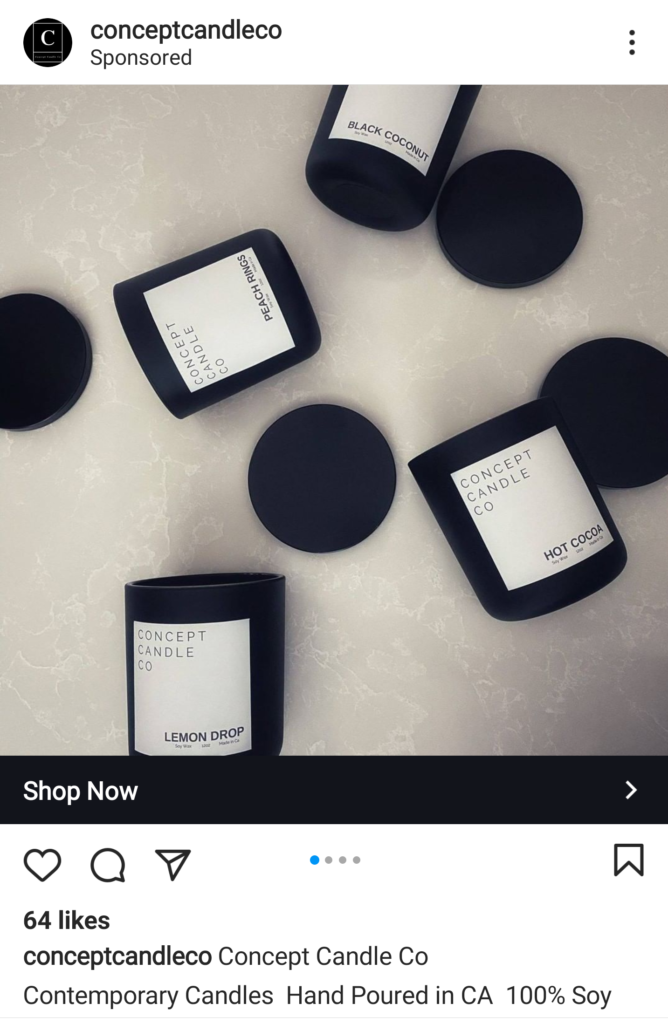
Stories Ads show your content as a story. Instagram inserts these ads into a user’s story feed even if they don’t follow you. If they swipe up on your ad, they’ll go to the link you specify—either your Etsy store or a specific product listing. Use Stories Ads to draw extra attention to a new product or sale.
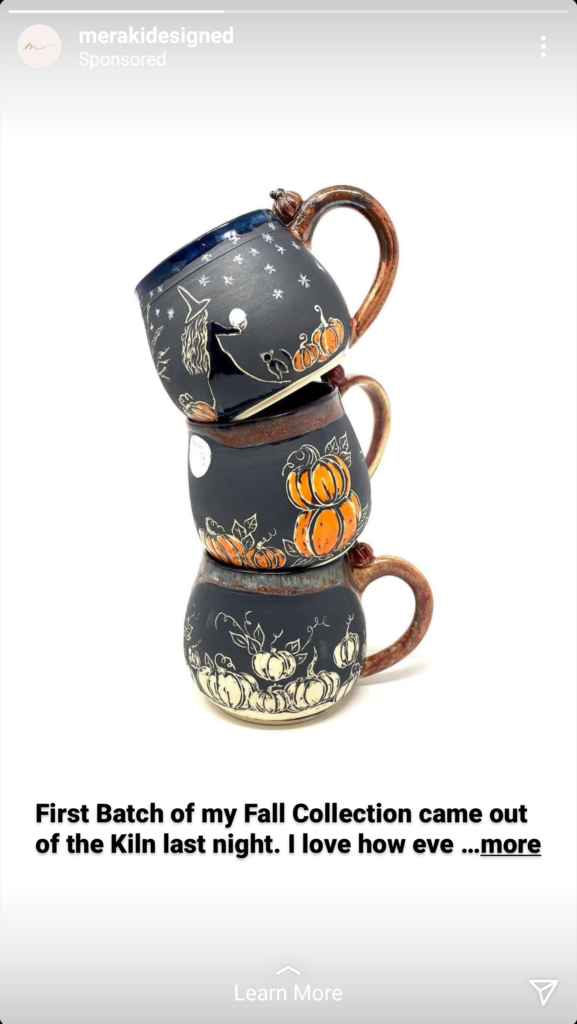
Video ads are ideal for grabbing attention since Instagram feeds are mostly static images. You don’t need a huge production—just a simple GIF like the one below or a short video showcasing your product will do. The goal here is to catch users’ eyes.
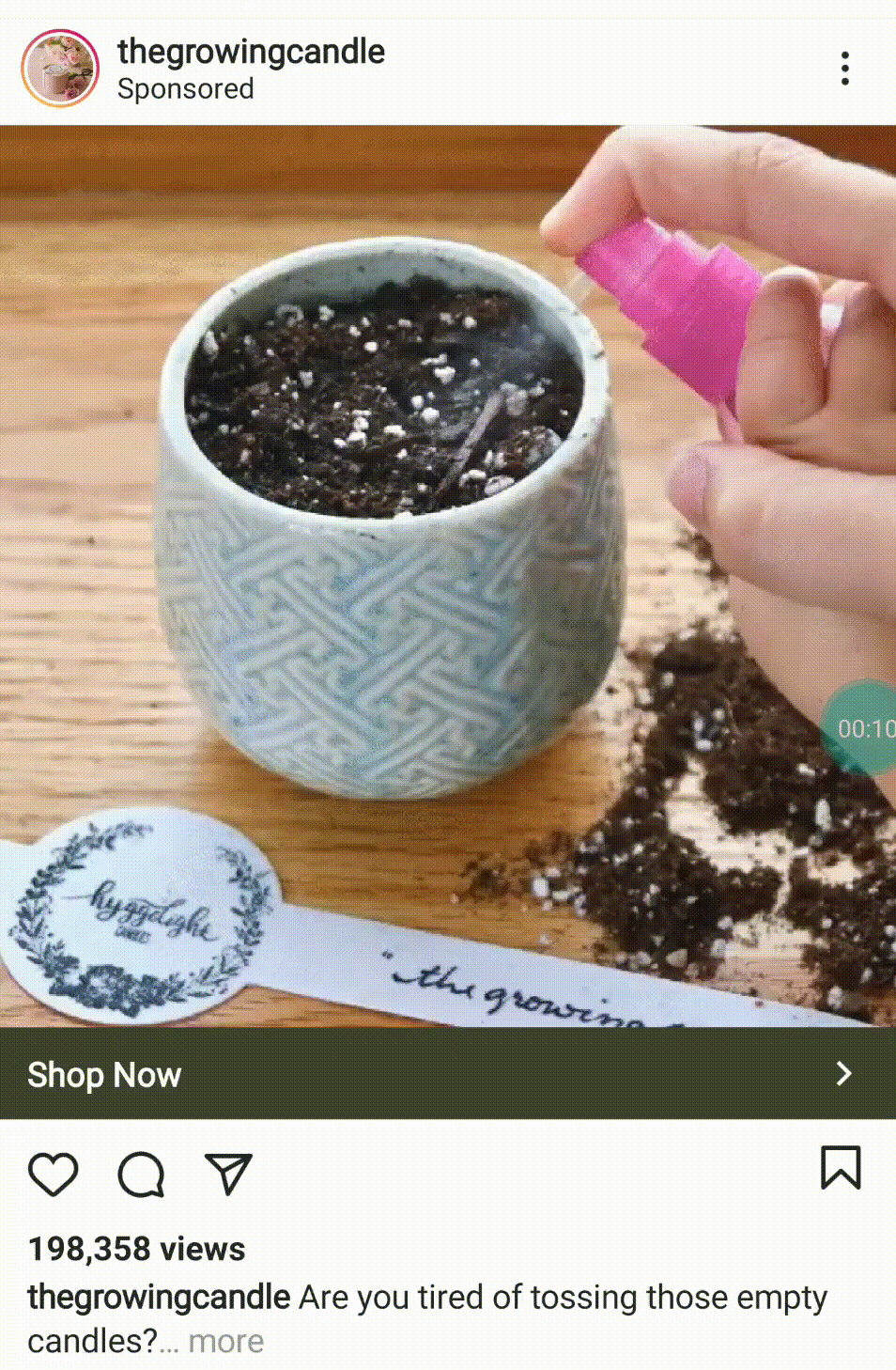
As with all things advertising, the key to choosing the best ad format for your Etsy business is experimentation. Try each ad type and see what drives the most engagement and revenue.
For more details, check out The Complete Guide to Instagram Ads: A Step-by-Step Guide to Advertising on Instagram.
To win at Etsy marketing, make sure you listen to your buyers
It’s time to get creative—take unique product photos, build a community on Facebook, run some test ads, and have fun! And then make sure you pay attention to the interactions with that content. What sparks discussion with your followers? What ads drive the most clicks?
The best Etsy sellers are particularly good at telling their story and good at making connections with people who buy their goods.”
Jennie Smith
The key to Etsy marketing is listening to your customers and making connections with them. These platforms are all about engagement. Comments, likes, and advertising metrics will tell you many things about your customers and what they want. You just have to learn to listen.
Create, listen, revise your approach, and repeat. Follow these steps, and you’ll be on your way to building a successful Etsy marketing strategy on two of the biggest social media platforms.
